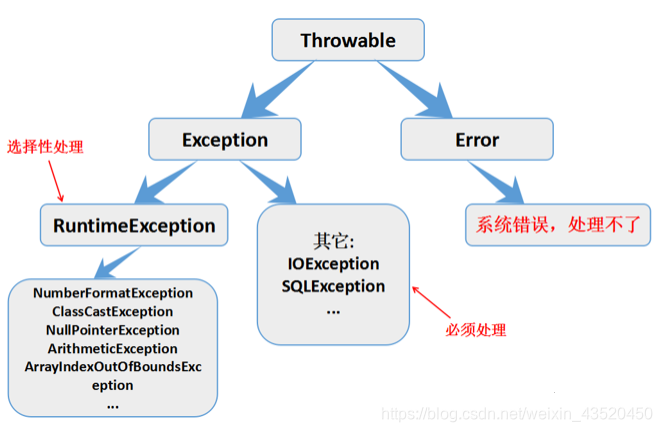Java异常的捕获与处理
Java提供了try(尝试)、catch(捕捉)、finally(最终)这三个关键字来处理异常。
在处理各种异常时,需要用到对应的异常类,指的是由程序抛出的对象所属的类。
一、异常处理的使用
由于finally块是可以省略的,异常处理格式可以分为三类:
try{ }——catch{ }
try{ }——catch{ }——finally{ }
try{ }——finally{ }
public class DealException
{
public static void main(String args[])
{
try
//要检查的程序语句
{
int a[] = new int[5];
a[10] = 7;//出现异常
}
catch(ArrayIndexOutOfBoundsException ex)
//异常发生时的处理语句
{
System.out.println("超出数组范围!");
}
finally
//这个代码块一定会被执行
{
System.out.println("*****");
}
System.out.println("异常处理结束!");
}
}可以看出,在异常捕捉的过程中要进行两个判断,第一是try程序块是否有异常产生,第二是产生的异常是否和catch()括号内想要捕捉的异常相同。
那么,如果出现的异常和catch()内想要捕捉的异常不相同时怎么办呢?事实上我们可以在一个try语句后跟上多个异常处理catch语句,来处理多种不同类型的异常。
public class DealException
{
public static void main(String args[])
{
try
//要检查的程序语句
{
int a[] = new int[5];
a[0] = 3;
a[1] = 1;
//a[1] = 0;//除数为0异常
//a[10] = 7;//数组下标越界异常
int result = a[0]/a[1];
System.out.println(result);
}
catch(ArrayIndexOutOfBoundsException ex)
//异常发生时的处理语句
{
System.out.println("数组越界异常");
ex.printStackTrace();//显示异常的堆栈跟踪信息
}
catch(ArithmeticException ex)
{
System.out.println("算术运算异常");
ex.printStackTrace();
}
finally
//这个代码块一定会被执行
{
System.out.println("finally语句不论是否有异常都会被执行。");
}
System.out.println("异常处理结束!");
}
}上述例子中ex.printStackTrace();就是对异常类对象ex的使用,输出了详细的异常堆栈跟踪信息,包括异常的类型,异常发生在哪个包、哪个类、哪个方法以及异常发生的行号。
二、throws关键字
throws声明的方法表示该方法不处理异常,而由系统自动将所捕获的异常信息抛给上级调用方法。
public class throwsDemo
{
public static void main(String[] args)
{
int[] a = new int[5];
try
{
setZero(a,10);
}
catch(ArrayIndexOutOfBoundsException ex)
{
System.out.println("数组越界错误!");
System.out.println("异常:"+ex);
}
System.out.println("main()方法结束。");
}
private static void setZero(int[] a,int index) throws ArrayIndexOutOfBoundsException
{
a[index] = 0;
}
}throws关键字抛出异常,“ArrayIndexOutOfBoundsException”表明setZero()方法可能存在的异常类型,一旦方法出现异常,setZero()方法自己并不处理,而是将异常提交给它的上级调用者main()方法。
三、throw关键字
throw的作用是手工抛出异常类的实例化对象。
public class throwDemo
{
public static void main(String[] args)
{
try
{
//抛出异常的实例化对象
throw new ArrayIndexOutOfBoundsException("\n个性化异常信息:\n数组下标越界");
}
catch(ArrayIndexOutOfBoundsException ex)
{
System.out.println(ex);
}
}
}我们能发现,throw好像属于没事找事,引发运行期异常,并自定义提示信息。事实上,throw通常和throws联合使用,抛出的是程序中已经产生的异常类实例。
ExceptionDemo
输出结果:
setZero方法开始:
setZero方法结束。
异常:java.lang.ArrayIndexOutOfBoundsException: 10
main()方法结束!
四、RuntimeException类
Exception和RuntimeException的区别:
Exception:强制性要求用户必须处理;
RunException:是Exception的子类,由用户选择是否进行处理。

五、自定义异常类
自定义异常类继承自Exception类,可以使用父类的大量的方法,也可自己编写方法来处理特定的事件。Java提供用继承的方式运行用户自己编写的异常类。
class MyException extends Exception
{
public MyException(String message)
{
super(message);
}
}
public class DefinedException
{
public static void main(String[] args)
{
try
{
throw new MyException("\n自定义异常类!");
}
catch(MyException e)
{
System.out.println(e);
}
}
}